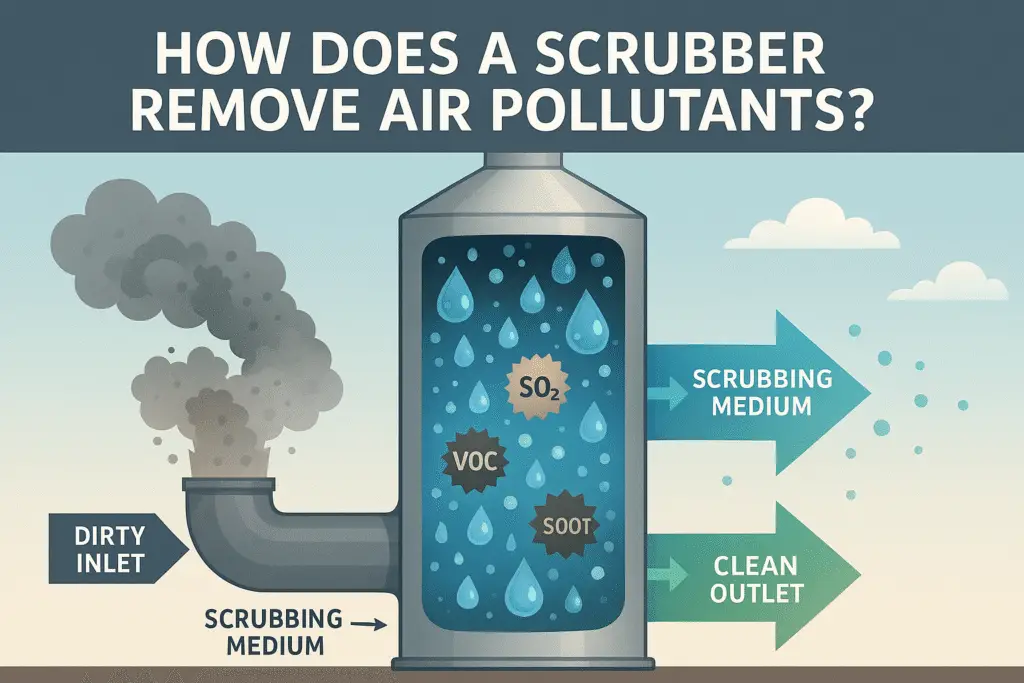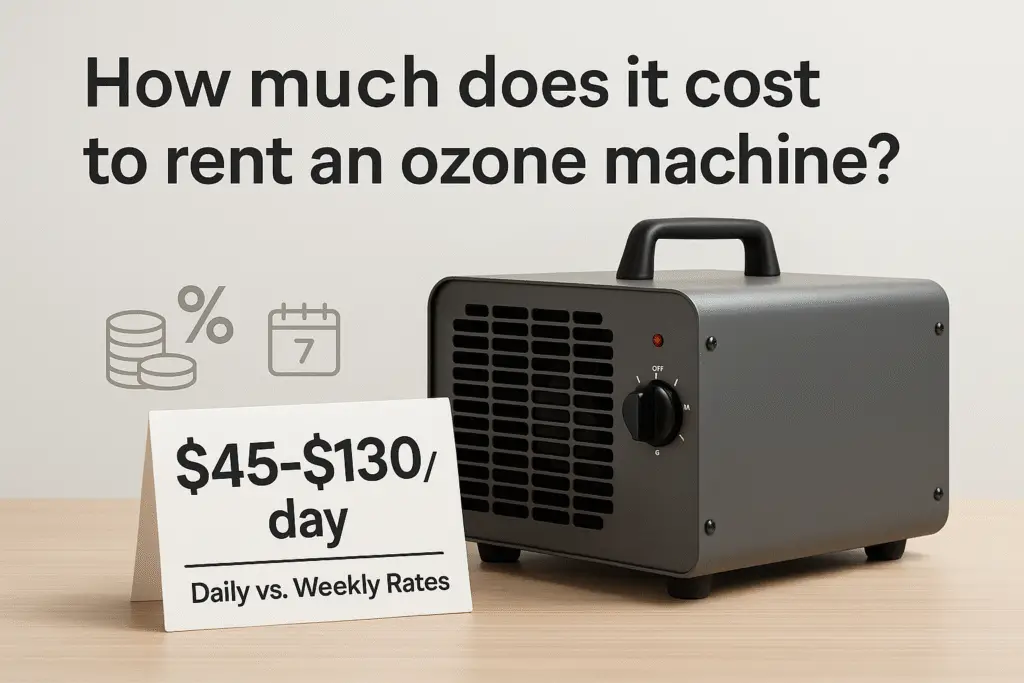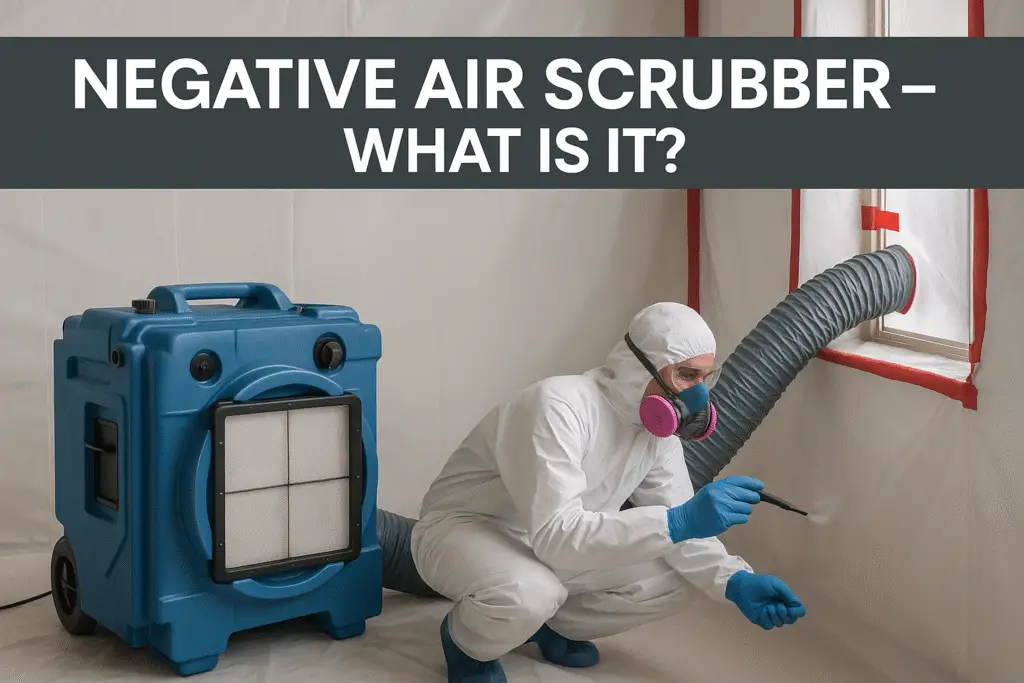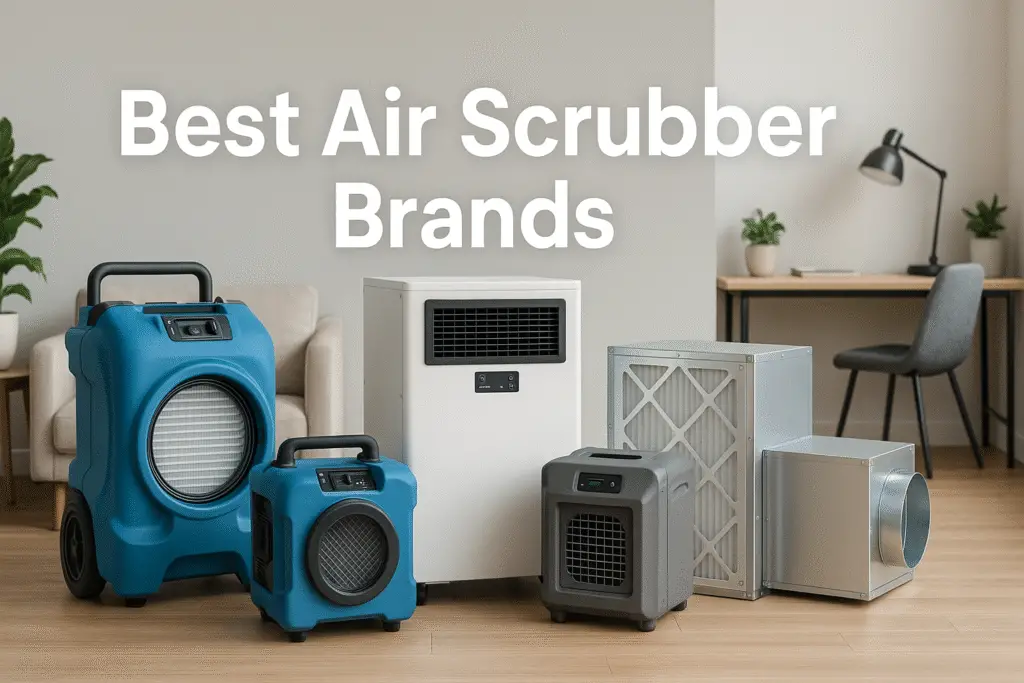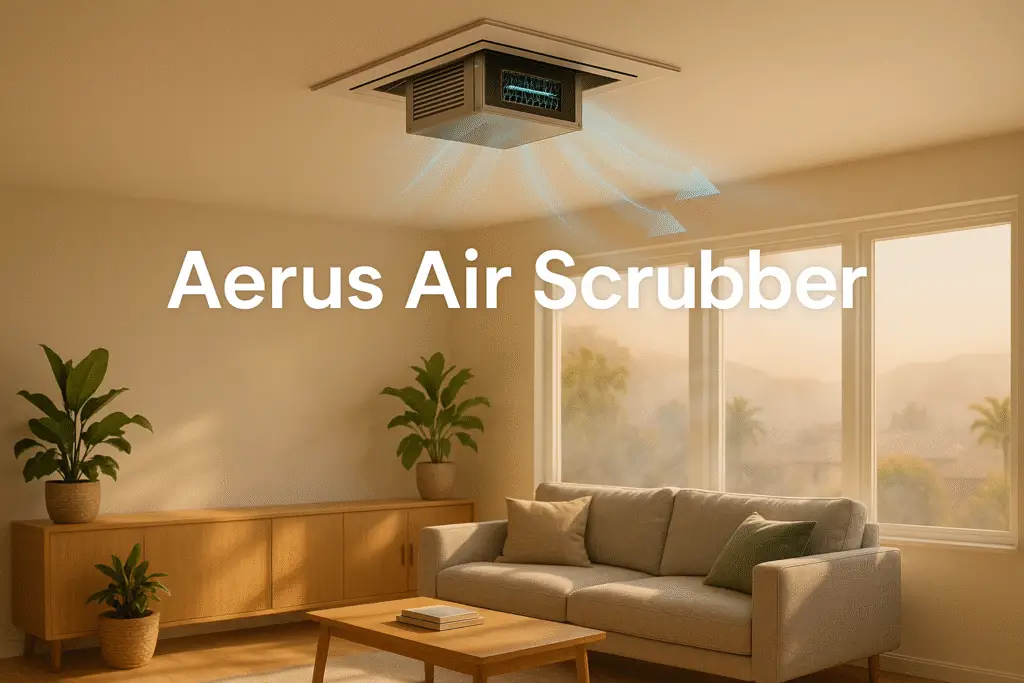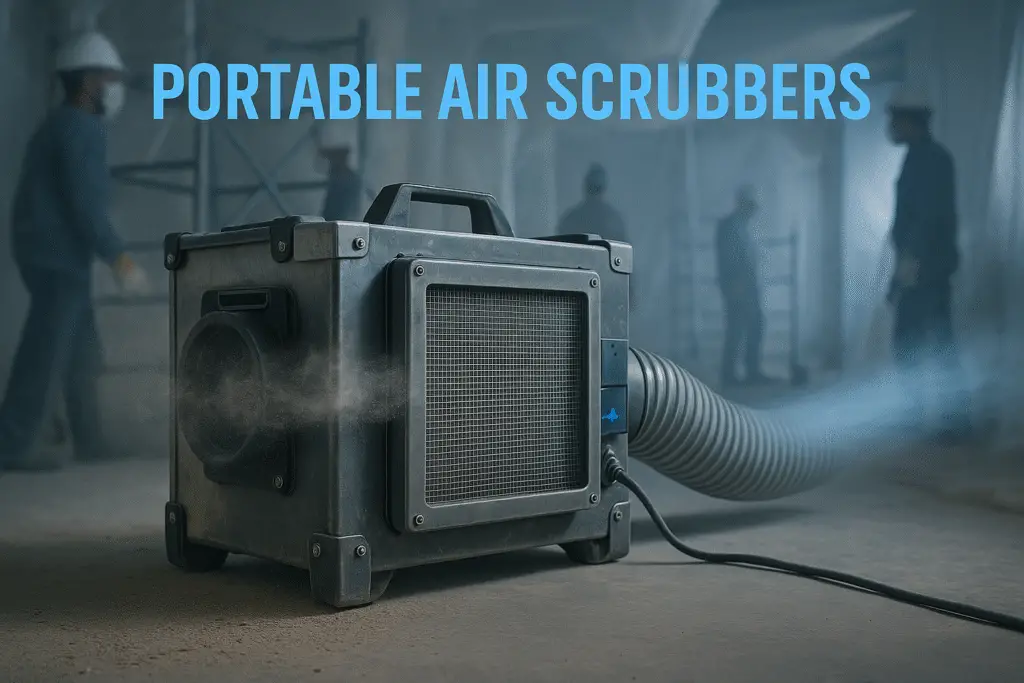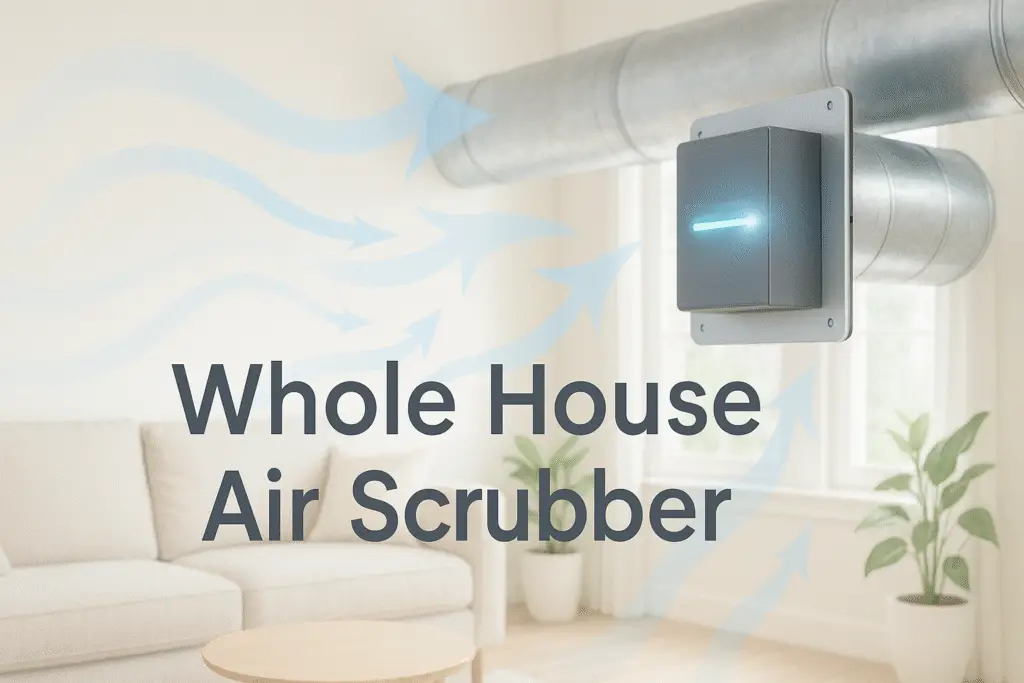An air scrubber removes air pollutants through a multi-stage filtration process that captures and neutralizes contaminants. These systems use combinations of physical filters, activated carbon, UV light, and ionic technology to trap particles, absorb gases, and kill microorganisms, significantly improving indoor air quality.
Quick Answer: Air scrubbers remove pollutants by drawing contaminated air through specialized filtration systems that trap particles (using HEPA filters), neutralize odors (with activated carbon), kill pathogens (via UV-C light), and break down harmful compounds (through photocatalytic oxidation). Their multi-stage purification process effectively cleanses indoor environments of particulates, volatile organic compounds (VOCs), bacteria, viruses, and allergens.
What is an Air Scrubber and How Does it Work?
An air scrubber is a specialized air purification device that removes contaminants from indoor air through a comprehensive filtration system. Unlike basic air filters that simply trap particles, air scrubbers actively draw in polluted air and process it through multiple purification technologies before releasing clean air back into the environment.
The fundamental working principle involves a powerful fan that pulls contaminated air through a series of filters and purification mechanisms. Each component targets specific types of pollutants:
- Pre-filters capture large particles like dust and hair
- HEPA filters trap microscopic particulates down to 0.3 microns
- Activated carbon layers absorb gases, VOCs, and odors
- UV-C light chambers destroy biological contaminants
- Ionizing or PCO technology neutralizes remaining pollutants
According to the Environmental Protection Agency (EPA), air scrubbers can remove between 99.97% to 99.999% of airborne particles, depending on the system’s specifications and technologies employed. This makes them significantly more effective than standard air filters that typically capture only 85-95% of contaminants.
The integration of multiple purification methods allows air scrubbers to address virtually all categories of indoor air pollutants, providing comprehensive protection for residential, commercial, and industrial spaces.
How Do HEPA Filters in Air Scrubbers Capture Particulate Matter?
HEPA (High-Efficiency Particulate Air) filters in air scrubbers capture particulate matter through a densely packed arrangement of randomly aligned fibers that trap particles through four distinct physical mechanisms: interception, impaction, diffusion, and electrostatic attraction.
According to the National Air Filtration Association (NAFA), true HEPA filters must remove at least 99.97% of particles as small as 0.3 microns—particles significantly smaller than the width of a human hair (approximately 70 microns). This remarkable efficiency is achieved through the following mechanisms:
- Direct interception: Particles following the airflow streamlines come within one particle radius of a fiber and adhere to it
- Inertial impaction: Larger particles unable to adjust to changing air streamlines collide directly with fibers
- Diffusion: Tiny particles move randomly due to Brownian motion, increasing their chances of contacting filter fibers
- Electrostatic attraction: Some HEPA filters incorporate charged fibers that attract oppositely charged particles
Research from the Journal of Aerosol Science demonstrates that HEPA filtration is most effective at capturing particles smaller than 0.1 microns and larger than 0.5 microns. The particles around 0.3 microns represent the “most penetrating particle size” (MPPS)—the most difficult size to capture. This is why HEPA performance is measured at this challenging 0.3-micron threshold.
In air scrubbers, HEPA filters are typically arranged downstream from pre-filters that remove larger particles, extending the HEPA filter’s operational life while maintaining optimal airflow and efficiency.
How Does Activated Carbon Filtration Remove Gaseous Pollutants?
Activated carbon filtration in air scrubbers removes gaseous pollutants through a process called adsorption, where molecular contaminants adhere to the carbon’s vast internal surface area. This porous structure creates millions of microscopic attachment sites that trap odors, VOCs, and other gaseous compounds.
The effectiveness of activated carbon lies in its remarkable physical properties:
- Surface area: Just one gram of activated carbon provides 32,000-40,000 square feet of surface area, according to the American Chemical Society
- Pore structure: Contains micropores (<2nm), mesopores (2-50nm), and macropores (>50nm) that capture different-sized molecular contaminants
- Van der Waals forces: Weak intermolecular attractions that bind gaseous molecules to the carbon surface
The adsorption process is particularly effective for volatile organic compounds (VOCs) like formaldehyde, benzene, and toluene, which are common in household products, building materials, and furnishings. Research from the Building and Environment journal indicates that properly designed activated carbon filters can remove 85-95% of VOCs from indoor air.
Many premium air scrubbers enhance basic activated carbon with specialized additives:
- Potassium iodide impregnation improves capture of ammonia and formaldehyde
- Zeolite blends enhance removal of specific gases and extend filter life
- Catalytic carbon provides superior performance against sulfur compounds and chloramines
The effectiveness of activated carbon filtration depends on several factors including contact time (how long the air remains in the filter), carbon quantity, pore size distribution, and contaminant concentration. Most commercial air scrubbers optimize these parameters to ensure maximum removal of gaseous pollutants.
What Role Does UV-C Light Play in Air Scrubber Purification?
UV-C light in air scrubbers plays a critical sterilization role by disrupting the DNA and RNA of microorganisms, preventing them from reproducing or causing infections. This germicidal irradiation effectively neutralizes bacteria, viruses, mold spores, and other biological contaminants as air passes through the system.
UV-C light operates at a specific wavelength of 253.7 nanometers, which has been scientifically proven to be most effective for microbial destruction. According to research published in the Journal of Applied Microbiology, proper UV-C exposure can achieve a 99.9% reduction in airborne pathogens.
The effectiveness of UV-C sterilization depends on three key factors:
- Intensity (dose): Measured in microwatts per square centimeter (μW/cm²)
- Exposure time: How long microorganisms remain in the UV-C field
- Distance: Proximity of pathogens to the UV-C light source
High-quality air scrubbers carefully engineer these parameters to ensure sufficient UV-C exposure as air moves through the system. The American Society of Heating, Refrigerating and Air-Conditioning Engineers (ASHRAE) recommends UV-C dosages of 1,500-10,000 μWs/cm² for effective air disinfection, depending on the target microorganisms.
Modern air scrubbers often incorporate advanced UV-C implementations:
- UV-C arrays: Multiple lamps positioned to maximize exposure
- Reflective chambers: Special surfaces that amplify UV-C effectiveness
- UV-C LED technology: Newer systems using light-emitting diodes for more efficient operation
It’s worth noting that UV-C light works synergistically with HEPA filtration—while HEPA captures microorganisms, UV-C ensures they cannot reproduce, providing comprehensive protection against biological contaminants in indoor environments.
How Does Photocatalytic Oxidation (PCO) Break Down Pollutants?
Photocatalytic Oxidation (PCO) in air scrubbers breaks down pollutants through a chemical reaction that converts harmful compounds into harmless substances like water and carbon dioxide. This advanced technology uses ultraviolet light and a catalyst (typically titanium dioxide) to create powerful oxidizing agents that decompose organic contaminants at the molecular level.
The PCO process follows these steps:
- UV light strikes the titanium dioxide (TiO₂) catalyst coating
- This energy creates electron-hole pairs in the TiO₂ surface
- The electrons and holes react with water and oxygen in the air
- Highly reactive hydroxyl radicals (•OH) and superoxide ions (O₂⁻) form
- These oxidizing agents attack and break down organic pollutants
According to research published in the Journal of Hazardous Materials, PCO technology can decompose over 300 different volatile organic compounds (VOCs), including formaldehyde, benzene, toluene, and xylene. Studies from the Lawrence Berkeley National Laboratory demonstrate PCO effectiveness ranges from 20-80% for single-pass removal of most VOCs, with cumulative effectiveness reaching 95-99% with continuous operation.
Modern air scrubbers enhance PCO performance through several innovations:
- Advanced catalyst formulations: Doped TiO₂ or multi-metal catalysts improve reaction rates
- Honeycomb structures: Maximize surface area for catalyst coating
- Combined UV wavelengths: Utilizing both UV-A and UV-C for broader effectiveness
- Hydrophilic coatings: Prevent catalyst fouling and extend operational life
Unlike filtration methods that simply trap pollutants, PCO actively destroys contaminants, converting them into harmless byproducts. This makes it particularly valuable for eliminating odors and breaking down chemical compounds that might be difficult to capture through conventional filtration alone.
How Do Ionization Technologies Enhance Air Scrubber Performance?
Ionization technologies enhance air scrubber performance by electrically charging airborne particles, causing them to cluster and become easier to capture or fall out of circulation. This process works through the generation of negative ions that attach to positively charged pollutants, significantly improving the system’s ability to remove microscopic contaminants.
The ionization process operates through several mechanisms:
- Bipolar ionization: Generates both positive and negative ions that neutralize charged particles
- Negative ion generation: Creates negative ions that attach to positively charged contaminants
- Electrostatic precipitation: Charges particles that are then attracted to collection plates
- Ion clustering: Charged particles combine to form larger aggregates that drop from the air
Research from the Journal of Electrostatics indicates that ionization can enhance particulate removal efficiency by 40-65% compared to standard filtration alone. The technology is particularly effective against ultrafine particles smaller than 0.1 microns—contaminants that often escape conventional HEPA filtration.
Modern air scrubbers implement ionization through several approaches:
- Needlepoint bipolar ionization (NPBI): Creates ions without producing harmful ozone
- Cold plasma generation: Forms a plasma field that creates ions and reactive oxygen species
- Corona discharge: Controlled electrical discharge that produces ions (in systems designed to minimize ozone)
According to studies published in Building and Environment, advanced ionization technologies can effectively reduce concentrations of bacteria and viruses by 90-99% in indoor environments. This occurs both through direct microbial deactivation and through enhanced particle agglomeration that improves filtration capture rates.
Some premium air scrubbers combine ionization with other technologies like activated carbon and HEPA filtration, creating a multi-layered approach that addresses virtually all categories of indoor air pollutants—from particulates and microorganisms to gases and VOCs.
What Types of Pollutants Can Air Scrubbers Effectively Remove?
Air scrubbers can effectively remove a comprehensive range of indoor pollutants through their multi-stage purification systems. These devices target particulates, biological contaminants, chemical compounds, and odors with varying degrees of efficiency depending on the specific technologies implemented.
The major categories of pollutants addressed by air scrubbers include:
Particulate Matter
Air scrubbers excel at removing particulate matter in various size ranges:
- PM10 (≤10 microns): Pollen, dust, pet dander, mold spores – 95-99% removal
- PM2.5 (≤2.5 microns): Smoke particles, fine dust, combustion byproducts – 99% removal
- Ultrafine particles (≤0.1 microns): Virus particles, atmospheric aerosols – 80-95% removal
According to the Association of Home Appliance Manufacturers (AHAM), HEPA-equipped air scrubbers can achieve a Clean Air Delivery Rate (CADR) of 100-450 cubic feet per minute for particles, depending on the model and fan speed.
Biological Contaminants
UV-C light and PCO technologies target living organisms:
- Bacteria: E. coli, Staphylococcus, Streptococcus – 99.9% reduction
- Viruses: Influenza, coronavirus, rhinovirus – 99.4-99.9% reduction
- Mold spores: Aspergillus, Penicillium, Cladosporium – 98% reduction
- Allergens: Dust mite waste, cockroach allergens – 98-99% reduction
Chemical Compounds
Activated carbon and PCO systems address gaseous pollutants:
- Volatile Organic Compounds (VOCs): Formaldehyde, benzene, toluene – 85-95% reduction
- Nitrogen Dioxide (NO₂): From combustion sources – 70-90% reduction
- Sulfur Dioxide (SO₂): Industrial emissions – 60-80% reduction
- Ozone (O₃): Atmospheric pollutant – 30-70% reduction
Odors
Air scrubbers effectively neutralize a wide range of unpleasant odors:
- Cooking odors: 85-95% reduction
- Pet odors: 80-90% reduction
- Smoke: 70-90% reduction
- Chemical smells: 75-95% reduction
Research from the Indoor Air Quality Scientific Findings Resource Bank indicates that properly sized air scrubbers can reduce overall indoor pollutant concentrations by 50-80% within 30-60 minutes of operation in a closed environment.
It’s important to note that removal efficiency depends on several factors including air scrubber technology, room size, air exchange rate, and pollutant concentration. High-end models with multiple purification technologies generally provide more comprehensive pollutant removal than basic units.
How Do Commercial and Industrial Air Scrubbers Differ from Residential Units?
Commercial and industrial air scrubbers differ from residential units in scale, capacity, durability, filtration efficiency, and specialized features designed for professional environments. These differences reflect the more demanding requirements of larger spaces and specialized applications.
The key distinctions include:
Processing Capacity and Size
- Residential units: Typically process 100-400 cubic feet per minute (CFM)
- Commercial units: Process 500-1,500 CFM
- Industrial units: Process 1,000-10,000+ CFM
According to the American Society of Heating, Refrigerating and Air-Conditioning Engineers (ASHRAE), commercial spaces require 5-10 air changes per hour, necessitating the higher capacity of commercial and industrial scrubbers.
Construction and Durability
- Residential units: Typically made with ABS plastic or lightweight metals
- Commercial units: Feature reinforced housings, higher-grade materials
- Industrial units: Built with heavy-gauge steel, weatherproof coatings, and industrial-grade components designed for 24/7 operation
Filtration Systems
- Residential units: Usually feature 1-3 stage filtration with HEPA and carbon
- Commercial units: Often include 3-5 stage filtration with specialized media
- Industrial units: May incorporate 5+ stages with application-specific filters (chemical scrubbing, high-temperature particulate capture, explosion-proof designs)
The National Air Filtration Association notes that industrial scrubbers often use MERV 16-20 rated filters (higher than typical residential HEPA) and may include specialized media for specific contaminants.
Specialized Features
Commercial and industrial units often include:
- Remote monitoring capabilities: WiFi/Ethernet connectivity with performance dashboards
- Variable speed drives: For energy efficiency and noise control
- Pressure differential monitoring: To optimize filter replacement timing
- Multiple inlet/outlet configurations: For integration with existing HVAC
- Explosion-proof options: For hazardous environments
- Negative air pressure capability: For containment applications
Application-Specific Designs
Industrial air scrubbers are often customized for specific industries:
- Healthcare: Enhanced UV-C, ULPA filtration, antimicrobial coatings
- Manufacturing: Oil mist collection, metal dust capture, solvent vapor control
- Food processing: Sanitizable surfaces, condensation control
- Remediation: Portable designs with high CFM, multi-stage filtration
- Chemical processing: Corrosion-resistant materials, specialized chemical media
According to the Indoor Air Quality Association, industrial-grade air scrubbers also feature significantly longer filter life—often 3-5 times that of residential units—to accommodate continuous operation in demanding environments.
While residential units prioritize aesthetics, quiet operation, and consumer-friendly features, commercial and industrial scrubbers emphasize performance, durability, and specialized functionality tailored to professional applications.
What Maintenance Do Air Scrubbers Require for Optimal Performance?
Air scrubbers require regular maintenance to maintain optimal performance, including filter replacements, UV lamp changes, system cleaning, and periodic professional inspections. Proper maintenance ensures continued effectiveness and prevents the buildup of captured contaminants that could reduce performance or be released back into the air.
The essential maintenance requirements include:
Filter Replacement Schedule
Different filter components require replacement at varying intervals:
- Pre-filters: Every 30-90 days, depending on pollution levels
- HEPA filters: Every 6-12 months (12-18 months for high-capacity units)
- Activated carbon filters: Every 3-6 months, or when odor removal efficiency decreases
- Specialized media: According to manufacturer specifications (typically 6-12 months)
Research from the EPA’s Building Assessment Survey and Evaluation (BASE) study shows that neglected filters can result in up to a 60% reduction in air purification efficiency.
UV-C Lamp Maintenance
- Replacement interval: Every 9-14 months, even if still illuminated
- Cleaning: Quarterly gentle dusting with soft cloth (when unit is unplugged)
- Inspection: Monthly visual check for proper operation
According to the Illuminating Engineering Society, UV-C lamps maintain only about 60-70% of their germicidal effectiveness after 9,000 hours of use, necessitating regular replacement despite still appearing functional.
System Cleaning
- External surfaces: Weekly dusting and monthly deeper cleaning
- Air intake grilles: Monthly vacuum or wipe-down
- Fan assemblies: Quarterly cleaning to remove dust buildup
- Interior chambers: Semi-annual cleaning following manufacturer guidelines
- Collection plates (electrostatic units): Monthly cleaning or as indicated by performance
Professional Maintenance
For optimal performance, schedule professional maintenance:
- Annual inspection: Complete system evaluation and cleaning
- Performance testing: Verification of airflow rates and filtration efficiency
- Seal inspection: Checking for air bypass around filters
- Motor and fan service: Lubrication and inspection of moving parts
- Control system verification: Testing of sensors and automated functions
The National Air Duct Cleaners Association recommends that commercial air scrubbers receive professional inspection at least annually, while industrial units may require quarterly professional maintenance.
Monitoring Indicators
Modern air scrubbers include several indicators to help determine maintenance needs:
- Filter replacement lights: Based on usage hours or pressure differential
- Airflow indicators: Show reduced performance due to filter loading
- UV lamp status lights: Indicate lamp function and replacement timing
- Performance monitoring: Some units track particle count reduction efficiency
Regular maintenance not only ensures optimal air cleaning performance but also extends the operational life of the air scrubber. According to the Journal of Occupational and Environmental Hygiene, properly maintained air purification systems can maintain 90-95% of their original efficiency throughout their service life, while neglected units may drop to 30-40% efficiency within a year of operation.
What Are the Latest Innovations in Air Scrubber Technology?
The latest innovations in air scrubber technology include advanced molecular filtration, smart connectivity features, enhanced energy efficiency, portable professional-grade systems, and sustainable design principles. These developments are pushing air purification capabilities beyond traditional methods while making systems more user-friendly and environmentally responsible.
Key technological advancements include:
Advanced Molecular Filtration
- Graphene-based filters: Ultra-thin graphene oxide membranes can trap particles as small as 0.03 microns while maintaining higher airflow than traditional HEPA filters
- Metal-organic frameworks (MOFs): Crystalline materials with unprecedented surface area (up to 7,000 m²/g) that can selectively capture specific gas molecules
- Catalytic converters: Room-temperature catalysts that convert VOCs and other pollutants into harmless compounds without UV light
Research published in Nature Materials demonstrates that these advanced filtration materials can achieve 99.9% removal efficiency for particles down to 0.01 microns while reducing airflow resistance by 15-30% compared to traditional HEPA media.
Smart Connectivity and Automation
- Advanced sensor arrays: Real-time monitoring of multiple pollutants (PM1.0, PM2.5, PM10, VOCs, CO₂) with machine learning algorithms that optimize filtration
- IoT integration: Connection with smart home systems and mobile apps for remote monitoring and control
- Predictive maintenance: AI-driven analytics that forecast filter life and system performance based on usage patterns
- Geofencing capabilities: Automatic operation based on occupancy and location data
According to market research from Grand View Research, smart air purification systems are projected to grow at a compound annual growth rate of 12.1% through 2028, reflecting strong consumer and commercial demand for connected purification solutions.
Energy Efficiency Improvements
- DC brushless motors: Reduce energy consumption by 30-50% compared to traditional motors
- Advanced airflow dynamics: Computational fluid dynamics-optimized internal designs that reduce pressure drop
- Adaptive purification: Systems that adjust fan speed and filtration intensity based on actual pollution levels
- Solar integration: Renewable energy options for portable and remote units
The American Council for an Energy-Efficient Economy notes that next-generation air scrubbers can achieve the same purification results while consuming 40-60% less energy than models from just 5-7 years ago.
Portable Professional-Grade Systems
- Compact industrial capacity: High-CFM units in smaller form factors for professional use
- Modular designs: Stackable or connectable units that scale with application needs
- Multi-mode operation: Systems that can switch between air scrubbing, negative air, and positive pressure modes
- Ruggedized construction: Shock-resistant, water-resistant designs for field use
Sustainable and Circular Design
- Washable/reusable components: Pre-filters and even some main filters designed for cleaning and reuse
- Biodegradable filter media: Plant-based filter materials that reduce environmental impact
- Filter recycling programs: Manufacturer take-back initiatives for spent filters
- Low-VOC construction: Housing and components made without harmful emissions
The Sustainable Products Initiative from the International Association of Air Purifier Manufacturers indicates that leading brands are now designing products with 70-90% recyclable or biodegradable components, significantly reducing environmental footprint.
These innovations are collectively transforming air scrubbers from simple filtration devices into comprehensive air quality management systems that respond intelligently to changing conditions while minimizing resource consumption and environmental impact.
How Can You Choose the Right Air Scrubber for Your Needs?
Choosing the right air scrubber requires evaluating your specific air quality concerns, space requirements, filtration needs, and budget considerations. The optimal system will balance these factors while providing effective purification for your particular environment and contamination challenges.
Follow these steps to select the most appropriate air scrubber:
Assess Your Air Quality Concerns
Identify your primary pollutants of concern:
- Dust and allergens: Focus on HEPA filtration efficiency
- Odors and chemicals: Prioritize activated carbon and molecular filtration
- Mold and bacteria: Look for UV-C and antimicrobial features
- Smoke and VOCs: Seek systems with multi-stage filtration including PCO
- Industrial contaminants: Consider specialized media for specific chemicals
The American Lung Association recommends conducting an indoor air quality assessment to identify specific pollutants before selecting purification equipment.
Calculate Space Requirements
Determine the appropriate capacity using these guidelines:
- Room coverage: Air scrubber should handle at least 2-3 times the room’s square footage
- Air Changes Per Hour (ACH): Aim for 4-5 ACH for residential spaces, 6-10 for commercial
- Clean Air Delivery Rate (CADR): Should match or exceed 2/3 of the room’s square footage
For example, a 300 sq. ft. room would require a minimum CADR of 200 for effective purification. For environments with higher pollution loads, the Association of Home Appliance Manufacturers recommends increasing these values by 25-50%.
Evaluate Filtration Technology
Select appropriate filtration based on your needs:
| Technology | Best For | Effectiveness |
|---|---|---|
| True HEPA (H13+) | Allergies, dust, pollen | 99.97-99.99% of particles ≥0.3 microns |
| Activated Carbon | Odors, VOCs, smoke | 85-95% of gaseous pollutants |
| UV-C Light | Bacteria, viruses, mold | 99%+ sterilization with sufficient exposure |
| PCO/Photocatalytic | Chemicals, VOCs, odors | 70-90% breakdown of organic compounds |
| Ionization | Ultrafine particles, allergens | 40-60% improvement in particle removal |
The EPA and the American Society of Heating, Refrigerating and Air-Conditioning Engineers (ASHRAE) recommend multi-stage systems for comprehensive air quality management.
Consider Practical Factors
- Noise levels: Measured in decibels (dB), look for units under 50dB for living spaces
- Energy consumption: Check ENERGY STAR ratings and annual operating costs
- Maintenance requirements: Consider filter replacement costs and schedules
- Mobility needs: Evaluate weight, handles, casters if portability is required
- Smart features: Assess value of programmability, sensors, remote control
Compare Value and Certification
Look for important certifications and features:
- AHAM Verified: Independent testing of CADR claims
- CARB Certified: Meets California’s strict ozone emission standards
- ENERGY STAR: Meets efficiency guidelines set by the EPA
- UL Listed: Meets safety standards from Underwriters Laboratories
- Warranty coverage: Longer warranties often indicate manufacturer confidence
According to Consumer Reports, there is not always a direct correlation between price and performance—mid-range units often provide excellent value compared to the most expensive models.
Special Application Considerations
- Allergies and asthma: Look for units certified by the Asthma and Allergy Foundation of America
- Construction/renovation: Consider rentable industrial units with high CFM
- Medical facilities: Seek hospital-grade units with ULPA filtration
- Chemical sensitivity: Choose units with zero off-gassing and sealed filtration
- High humidity environments: Select models with corrosion resistance and moisture handling
Remember that the most effective air quality strategy often combines air scrubbing with source control (removing pollution sources) and increased ventilation when possible. The American Industrial Hygiene Association emphasizes this multi-faceted approach for optimal indoor air quality management.
Conclusion: Maximizing Air Scrubber Effectiveness for Cleaner Indoor Air
Air scrubbers provide powerful and comprehensive protection against indoor air pollutants through their multi-stage purification technologies. By combining HEPA filtration, activated carbon adsorption, UV-C sterilization, photocatalytic oxidation, and ionization, these systems effectively address virtually all categories of air contaminants.
To maximize the effectiveness of your air scrubber investment:
- Select the right size and technology for your specific space and air quality concerns
- Position units strategically for optimal airflow and coverage
- Maintain regular filter replacement schedules to ensure continued performance
- Consider complementary strategies like source control and improved ventilation
- Monitor air quality improvements with sensors or testing to validate performance
Research from the Indoor Air Quality Association demonstrates that properly selected and maintained air scrubbers can reduce indoor pollutant concentrations by 80-95%, significantly improving respiratory health, reducing allergy symptoms, and creating healthier living and working environments.
As air scrubber technology continues to advance with smarter sensors, improved filtration media, and enhanced energy efficiency, these systems will play an increasingly important role in comprehensive indoor air quality management—providing protection against both common pollutants and emerging airborne threats.
By understanding how these technologies work together and selecting the appropriate system for your needs, you can significantly improve your indoor air quality and create a healthier environment for yourself, your family, or your employees.
References
- Environmental Protection Agency. (2022). “Guide to Air Cleaners in the Home.” https://www.epa.gov/indoor-air-quality-iaq/guide-air-cleaners-home
- National Air Filtration Association. (2021). “Understanding MERV and HEPA Filtration Standards.” https://www.nafahq.org/understanding-merv-ratings/
- American Society of Heating, Refrigerating and Air-Conditioning Engineers. (2022). “ASHRAE Position Document on Filtration and Air Cleaning.” https://www.ashrae.org/file%20library/about/position%20documents/filtration-and-air-cleaning-pd.pdf
- Journal of Applied Microbiology. (2020). “Effectiveness of UV-C light for microbial decontamination in air purification systems.” Vol. 128, Issue 5, pp. 1421-1434.
- Journal of Hazardous Materials. (2021). “Photocatalytic oxidation for indoor air purification: A literature review.” Vol. 402, 123461.
- Indoor Air Quality Scientific Findings Resource Bank. (2022). “Effectiveness of Portable Air Cleaners.” Lawrence Berkeley National Laboratory.
- American Lung Association. (2023). “Indoor Air Pollutants and Health.” https://www.lung.org/clean-air/at-home/indoor-air-pollutants
- Association of Home Appliance Manufacturers. (2022). “Clean Air Delivery Rate Certification Program.” https://ahamverifide.org/ahams-air-filtration-standards/
